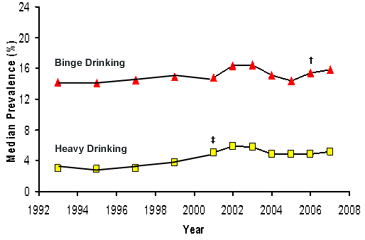 |
|
 |
 |
 |
Alcohol use is very common in our society. Drinking alcohol has immediate
effects that can increase the risk of many harmful health conditions.
Excessive alcohol use, either in the form of heavy drinking (drinking more
than two drinks per day on average for men or more than one drink per day on
average for women), or binge drinking (drinking 5 or more drinks during a single
occasion for men or 4 or more drinks during a single occasion for women), can
lead to increased risk of health problems such as liver disease or unintentional
injuries. According to recent national surveys, more than half of the adult U.S.
population drank alcohol in the past 30 days. Approximately 5% of the total
population drank heavily, while 15% of the population binge drank. From
2001–2005, there were approximately 79,000 deaths annually attributable to excessive alcohol use. In fact,
excessive alcohol use is the 3rd leading
lifestyle-related cause of death for people in the United States each year.
Alcohol use poses additional problems for
underage drinkers.
Prevalence of binge drinking and heavy drinking among adults in the
United States, 1993–2007.

[A text description
of this graph is also available.] Notes:
† Binge drinking data represent all respondents who report consuming 5 or
more drinks on an occasion through 2005. Data from 2006–2007 represent men
who report consuming 5 or more drinks on an occasion, and women who report
consuming 4 or more drinks on an occasion, during the past 30 days.
‡ 1993–2000 data represent all respondents aged 18 years and older who
report an average of two or more drinks per day (i.e., 60 or more alcoholic
drinks a month). Data from 2001–2007 represent all male respondents aged 18
years and older who report an average of more than 2 drinks per day, and
female respondents aged 18 years and older who report an average of more
than 1 drink per day.
Source
of data is the Behavioral
Risk Factor Surveillance System (BRFSS);
information about the BRFSS is available at
http://www.cdc.gov/brfss/index.htm.
Binge drinking data represent all respondents who report consuming
5 or more drinks on an
occasion through 2005. Data
from 2006 and 2007 represent men who report consuming
5 or more drinks on an
occasion, and women who report
consuming 4 or more drinks on an occasion, during the past 30 days.
1993–2000 data represent all respondents aged 18 years and older who report
an average of 2 or more drinks per day (i.e., 60 or more alcoholic drinks a
month).
2001–2007 data represent all male respondents aged 18 years and older who
report an average of more than 2 drinks per day, and female respondents aged
18 years and older who report an average of more than 1 drink per day.
Data are not available for the following years: 1994, 1996, 1998, 2000.
* Links to non-Federal organizations are
provided solely as a service to our users. Links do not constitute an
endorsement of any organization by CDC or the Federal Government, and none
should be inferred. The CDC is not responsible for the content of the individual
organization Web pages found at this link.
Page last reviewed: August 6, 2008
Page last modified: September 3, 2008
Content source: Division of Adult and Community Health,
National Center for Chronic Disease Prevention and
Health Promotion |
 |

|
Alcohol
Related Disease Impact (ARDI) |
|
Alcohol-Related Disease Impact (ARDI) software generates
estimates of alcohol-related deaths and Years of Potential
Life Lost (YPLL) due to alcohol consumption. |
|
|